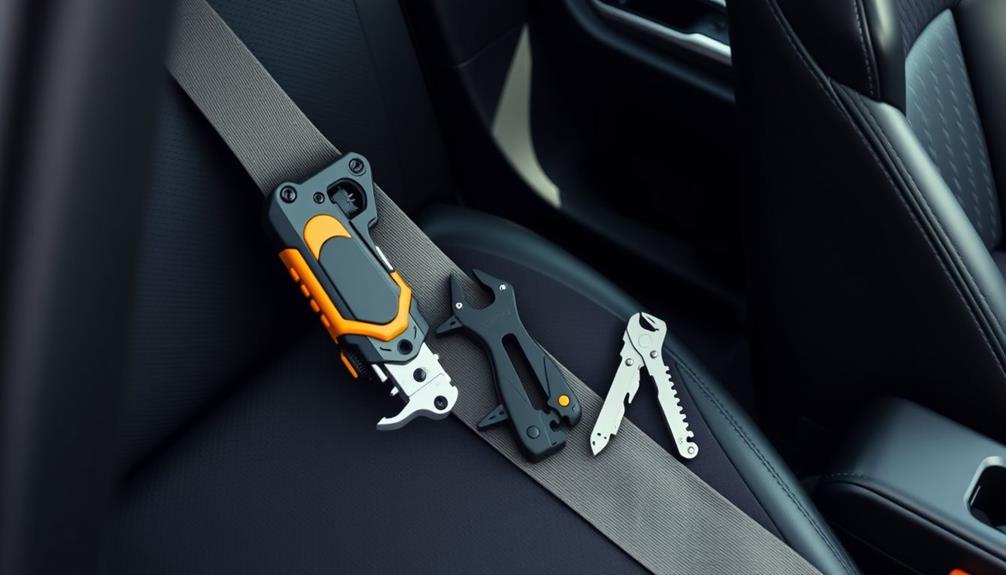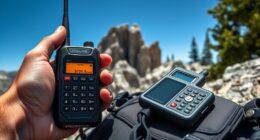Tornadoes are dangerous and can quickly destroy areas. They have winds over 200 MPH1. The Midwest and Southeast of the U.S. face the most risk of tornadoes1. To keep safe, knowing what to do before, during, and after a tornado is key.
Key Takeaways:
- Stay updated on tornado watches and warnings issued by the National Weather Service2.
- Identify safe shelter locations, such as basements or storm shelters, in advance1.
- Avoid windows, doors, and outside walls during a tornado1.
- Use text messaging or social media to communicate with family and friends when phone systems are down1.
- After a tornado, be cautious during cleanup and wear protective gear to prevent injuries1.
Understanding Tornadoes and Their Rispectible Risks
Tornadoes are intense and can tear through towns, destroying almost everything. They come from severe thunderstorms and have wind speeds over 200 miles per hour3. Knowing about tornadoes and the dangers they bring is key to keep safe. It helps us to prepare and protect our lives and homes.
In the U.S., tornadoes mostly hit the Midwest and Southeast. These places see more tornadoes because of their weather3. People living there must be ready and know what to do when a tornado comes. Being informed means being safer.
FEMA has made rules for building safe rooms for tornado safety3. These rooms must be built strong to stand up against tornado winds. Following the ICC 500 shelter rules makes these safe spots even safer during a storm3.
When tornadoes could happen, alert systems warn us. The Emergency Alert System (EAS) and NOAA Weather Radio give these warnings3. They tell us what to do and how to find safety. This can save lives.
Meteorologists play a big role in keeping us safe from tornadoes. They use weather data to forecast tornadoes3. Their work helps us get ready and protects us and our families.
| Tornado Risk Factors | Impact |
|---|---|
| High Winds | Tornadoes can reach intense wind speeds, exceeding 200 miles per hour3. |
| Geographical Regions | The Midwest and Southeast regions in the U.S. have a higher risk for tornadoes3. |
| Safe Room Construction | FEMA criteria outline safe room construction for tornado protection3. |
| Storm Shelter Standards | Adhering to ICC 500 standards enhances protection during tornadoes3. |
| Emergency Alert Systems | Emergency Alert System (EAS) and NOAA Weather Radio deliver emergency alerts3. |
| Meteorological Predictions | Meteorologists can predict favorable conditions for tornado formation3. |
To stay safe from tornadoes, we need to understand them. Staying informed, following safety steps, and taking action helps protect us. This way, we can face these powerful storms with confidence.
Tornado Watches and Warnings
Knowing what to do during a tornado can save lives. Meteorological agencies give out watches and warnings to tell us about tornado risks. It’s important to know the difference between a tornado watch and a warning, so you can act safely.
Tornado Watch
A tornado watch means tornadoes could happen. It tells us the weather is right for tornadoes to form. When there’s a tornado watch, check your emergency plans and get your safe room ready. Make sure it’s free of mess and has things like blankets and pillows to protect you from flying stuff. Last year, tornadoes caused 83 deaths in the U.S4.. Over the last 10 years, about 47 people died each year due to tornadoes4.
Tornado Warning
A tornado warning is more serious. It means a tornado is actually happening or could any minute. This is the time to find shelter fast. If you’re outside, find shelter or lie flat on the ground, covering your head, away from things that could hit you. Safe buildings are best during a tornado.
If you’re in a car, drive away from the tornado or pull over, buckle up, and cover your head. In 2011, 553 people died because of tornadoes, making it the deadliest year since 19504.
People living in mobile homes should find a sturdy building. Mobile homes aren’t safe, even if they’re tied down4. Stay in your shelter until it’s safe to leave. Authorities will let you know when that is. Reacting quickly to tornado watches and warnings is key to staying safe.
Staying informed and ready is vital for survival during tornadoes. A NOAA Weather Radio can alert you quickly5. Also, listen to radio and TV for updates5. By paying attention to experts, you can lessen the danger from tornadoes and keep safe.

| Tornado Watches | Tornado Warnings |
|---|---|
| Issued to indicate the possibility of tornadoes in a specific area | Issued when a tornado has been sighted or rotation has been detected on weather radar |
| Signal the need to review emergency plans and prepare a safe room | Require immediate action to seek shelter |
| 83 tornado-related deaths reported in the U.S. last year | 2011 marked the deadliest year for tornadoes in the U.S. since 1950 |
| Average of 47 tornado-related deaths per year in the U.S. over the past decade | Mobile homes considered unsafe even with tie-downs |
Creating a Tornado Preparedness Plan
Having a plan ready for tornado safety is key to protect you and your family. This plan includes finding safe spots, doing drills, and getting together emergency supplies and ways to communicate.
Identifying Safe Locations
First, figure out the best places to hide during a tornado. Tornadoes have hit every state in the U.S., so it’s a threat everywhere6. They mostly happen in spring and summer but can appear at any time6. Tornadoes are very powerful, with winds over 200 miles per hour6.
Practicing Tornado Drills
It’s smart to practice tornado drills regularly. This helps everyone know what to do if a tornado is coming. It’s also important to keep up with weather warnings. You can do this by watching local news or listening to NOAA weather radio6. Paying attention to weather changes and unusual noises can also give you a heads up about tornadoes6.
Emergency Supplies and Communication Devices
Make sure you have an emergency kit ready. It should have things like medicine, durable shoes, and how to shut off house utilities during a tornado6. It’s also vital to stay in touch. Have a battery-powered radio, flashlights, and extra batteries ready. Weather updates and warnings are on NOAA Weather Radio and regular radio or TV stations6.
A well-thought-out tornado plan can greatly improve your safety. Don’t forget to practice drills, keep up with warnings, and gather emergency items and communication tools.

| Statistical Data | Source |
|---|---|
| Tornadoes have been reported in every state in the U.S. | Link 1 |
| Tornadoes typically occur during spring and summer, but can happen at any time throughout the year. | Link 1 |
| Tornadoes can have wind speeds of 200 miles per hour or more. | Link 1 |
| Conducting periodic tornado drills can help ensure preparedness. | Link 1 |
| It is crucial to stay informed about storm warnings. | Link 1 |
| Instructions should be in place for where to take shelter during a tornado. | Link 1 |
Identifying Safe Shelter Locations
When a tornado warning comes, you must find a strong shelter quickly. Look for safe rooms, basements, or ground-level interior rooms in solid buildings. Stay away from mobile homes and trailers; they are not safe in tornadoes.
Safe rooms or storm shelters are built to stand against tornadoes. They have strong walls and doors to keep you safe7.
Basements are great because they are underground. They protect against strong winds better. Always go to the deepest part, far from windows7.
If you don’t have a safe room or basement, use internal rooms. Pick places without windows near the center. Protect yourself with heavy furniture7.
Mobile homes and trailers are very dangerous in tornadoes. They can’t handle tornado winds. If you live in one, plan to find a safer place early8.
Know your area’s emergency shelter plans. Places like schools have safe spots. Learn where these are and how to get there in an emergency7.
If outside or in a car when a tornado warning is out, find a strong building. Never hide under overpasses. If nothing else is available, find a low spot and protect your head and neck78.
Always look for safe spots like safe rooms, basements, or inside sturdy buildings when tornado warnings are issued. Avoid mobile homes. Know where public safe spots are. If you’re caught outside, find safety in a solid building or lie low on the ground78.

Staying Informed and Monitoring Weather Conditions
It’s important to stay updated and watch the weather during a tornado. Getting timely tornado alerts helps keep you, your family, and your home safe.
“Tornadoes can occur at any time of day or night, with nighttime tornadoes being more challenging to see and detect, thus potentially increasing their danger.”9
To remain informed, sign up for tornado alerts from local authorities. These alerts will inform you about tornado dangers, so you can act fast to stay safe.
Have a battery-powered radio ready for emergencies. It will give you the latest news on tornadoes near you during severe storms.
Also, make sure you have a way to keep your phone charged. Your phone is crucial for getting tornado updates and using weather apps for the latest info.
“About 1,200 tornadoes hit the United States every year with every state being at risk.”10
Always keep an eye on weather reports. Knowing about tornado watches and warnings helps you decide when to seek shelter or leave the area.
Understand that a tornado watch means tornadoes could happen. A warning means one is already happening or will soon. Act quickly if you hear a tornado warning.
If you own a business, make sure you have a tornado safety plan. This should include safe places to go and ways to keep in touch with everyone.
“Businesses should have a tornado preparedness plan to protect employees and minimize operational disruptions during tornado events.”9
Staying alert and ready is key to being safe during a tornado. Make sure to get alerts, watch the weather, and have a safety plan ready.

Gathering Emergency Supplies
When dealing with tornadoes, having the right supplies is key to keep you and your family safe. Putting together a tornado emergency kit is a smart move. This kit can really help during a storm.
Start with enough water. You’ll need at least one gallon per person each day11 for drinking and staying clean. Try to have a three-day water supply as a basic amount.
Check your emergency kit twice a year12. This ensures all items are fresh and ready to use. You should do this every six months12.
Restock your kit regularly, too12. Update food, batteries, and medical items. This keeps your kit ready with what you need.
The location of your kit matters12. Store it somewhere easy to get to, like a basement or closet. This way, it’s quick to grab if you need to hurry out.
A good flashlight and extra batteries are must-haves12. They keep you lit during blackouts. Having spare batteries means your light stays on longer.
Don’t skimp on first aid supplies. Having bandages, ointment, and wipes12 is a must. These can handle minor injuries from tornadoes.
Remember a can opener12. It seems minor but is crucial for canned food. Make sure it’s manual to work without power.
Keep up your hygiene with toothbrushes, toothpaste, soap, and sanitizer12. Staying clean reduces illness risk during emergencies.
Choose kit items that fit your needs. Think about tools to turn off utilities, emergency books, and radios12. These help you stay safe and informed.
If you have babies, add formula and diapers12. Their comfort and care are important too.
Pets need extra food stored away12. They rely on you for their food during emergencies.
Air quality can drop. Dust masks or cotton shirts12 can filter air. They’re helpful when air is filled with particles.
Have plastic sheeting and duct tape ready12. Use them for quick shelter fixes against dangers. This is vital while waiting out a storm.
In wet areas, bring rain gear to keep dry12. It guards against rain and prevents mold from moisture.
Don’t forget basics like paper towels12. They help keep areas clean and sanitary. This is important during and after storms.
Carry a fire extinguisher12. It can control fires, protecting you from further harm.
To help with stress, pack cards or a game12. They offer a break from the tension of emergencies.

Wear the right clothes. Jackets, hats, gloves, and sturdy shoes12 are essential. They protect you from bad weather, especially in cold areas.
Understanding Tornado Warning Signs
Knowing tornado warning signs can lead to quick actions to keep you safe. You might see a twisting, funnel-shaped cloud or debris moving towards you. Or hear a loud noise similar to a freight train.
Spotting these signs is key to knowing a tornado is near. This knowledge lets you find shelter fast and stay safe.
Tornadoes can hit quickly, often without much warning. Being ready and alert is critical.
In Texas, tornadoes happen quite often13. For Texans, understanding tornado signs and safety steps is very important.
Weather experts send out tornado warnings when they spot one or see it on radar13. These warnings mean you should find a safe place right away. Listening and acting quickly can keep you safe.
Tornado emergencies are rare but very serious13. If there’s an emergency, act fast. Find a safe spot and follow safety rules.
Safety systems like sirens and special radios can warn people of tornadoes13. These tools help everyone respond quickly to stay safe.
Weather experts can predict when tornadoes might form13. They look at the weather and the atmosphere. This helps people and communities prepare and take action when needed.
If there’s a tornado warning, go to a room without windows on the lowest floor13. It’s the safest place from the tornado’s strong winds and flying debris.
Mobile homes don’t protect well in tornadoes. If you live in one, know where to go for safety13. Find a sturdy building or community shelter ahead of time.
Outside with no shelter? Lie flat in a low spot and cover your head13. It might offer some protection against debris.
After a tornado, signal for help without speaking if you’re stuck. Stay away from damaged buildings and downed power lines13. This keeps you safe from further harm.
Use texts or social media to communicate after a disaster13. Phone systems might not work. These can help you stay connected and organize help.
Wear thick shoes, pants, and gloves during clean-up for safety13. This gear protects you from debris and other dangers after a tornado.

It’s vital to know how to spot a tornado coming. Being aware and ready lets you act quickly when weather gets bad.
Taking Shelter and Staying Safe During a Tornado
When you hear a tornado warning, act fast and find shelter. Head to a safe room, basement, or an inside room on the ground floor without windows. Protect yourself with things like furniture or blankets. Keep away from windows and outer walls. The CDC strongly advises to seek shelter or find a tornado-safe room if a tornado is near14. The best spot to hide in your home is an interior part of a basement14. If you live in a high-rise or don’t have a basement, go to an inside room on the lowest floor. Stay far from windows1415. Mobile homes and cars are not safe places during a tornado15.
If you’re outside, the CDC says to lie low in a ditch or depression14. Reacting quickly is vital because tornadoes come fast14. At your shelter place, have an emergency supply kit ready16. This kit should have water, food that doesn’t spoil, first aid items, flashlights, and batteries.
If there’s a tornado warning, don’t use lifts. Use the stairs to get to safety. It’s also key to keep an eye on weather updates through trustworthy sources like weather radios, the news, or apps on your phone. Following OSHA’s advice to have warning systems and safety procedures during tornadoes is smart16.

Once the tornado warning is over and it’s safe, be cautious leaving your shelter. Look out for dangers like fallen power lines, debris, and broken buildings. Listen to local authorities and emergency teams for advice on going back to damaged areas.
After a tornado, contacting others might be hard. Phone lines could be busy or not working. To stay in touch, texting or using social media is suggested. The Tuscaloosa County EMA lists storm shelters in Tuscaloosa County for those not living on campus15.
| Tornado Safety Precaution | Statistical Data Reference |
|---|---|
| Seek shelter in a safe room, basement, or interior room on the lowest level of a sturdy building without windows | 14 |
| Cover yourself with protective materials, such as furniture or blankets | – |
| Avoid windows and outside walls | – |
| Equip shelter locations with emergency supply kits | 16 |
| Monitor weather conditions through reliable sources | 16 |
| Avoid using elevators and take the stairs | – |
| Exercise caution when leaving the shelter location | – |
| Use text moreessages or social media for post-tornado communication | 15 |
Safety Precautions After a Tornado
After a tornado hit, it’s key to act fast to keep safe. You need to check the damage, help others, and watch out for dangers. Doing these can help everyone recover quicker.
Assessing Damage
When it’s safe, look over your property for damage. Search for big problems like broken walls or roofs, and avoid fallen power lines. Remember, it’s important to take pictures for insurance.
Helping Others
Now is the time to help those around you. Check on neighbors, friends, and family. If anyone is hurt, call 911 right away and help out if you know CPR. Your help can really make a difference.
Safeguarding Against Hazards
Be careful of hazards in places hit by the tornado. Stay away from damaged buildings which might fall down. Make sure to wear gloves, boots, and a mask to stay safe from debris and germs.
It’s also vital to keep up with news for more weather alerts. Using texts and social media works best for updates because phone lines might be busy.

By taking these steps and helping others, you play a big part in the recovery. Staying safe after a tornado is important for getting things back to normal quickly.
| Tornado Safety Guidelines and Tips | Tornado Watch17 | Tornado Warning2 |
|---|---|---|
| Stay informed through NOAA weather radio or local broadcast media. | Covers a large area including numerous counties or even states. | Issued when a developing tornado is detected, usually covering portions of one or two counties for an hour or less. |
| Seek shelter in a basement or the lowest floor of a building. | It is recommended to have a family emergency plan, including a safe room in the home, such as a basement or storm cellar17. | Recommends seeking basement or lowest floor of a building, putting as many walls between oneself and the outside, avoiding windows, and preparing for obscured tornadoes especially at night2. |
| Avoid windows and put as many walls between yourself and the outside as possible. | ||
| Have a family emergency plan in place. | ||
| If no shelter is available in a tornado-prone area, consider relocating to a sturdier building or structure. | Guidance against taking shelter under highway overpasses2. | |
| Listen to local news for updates on possible additional tornado watches or warnings. | Continue listening to local news for updates on possible additional tornado watches or warnings17. | |
| Communicate through text messages or social media rather than phone calls, as they are more reliable forms of communication after a tornado. | Text messages or social media are suggested as more reliable forms of communication after a tornado than phone calls17. | |
| Check for property damage and be cautious of hazards like downed power lines. | It is important to check for property damage after a tornado and be cautious of dangers like downed power lines17. | |
| Call 911 and provide first aid if trained to do so if someone is injured. | If someone is injured, it is advised to call 911 and provide first aid if trained until emergency responders arrive17. |
Mental and Emotional Well-being
Experiencing a tornado can leave you feeling shocked and unsure. It’s not just about the destruction you see18. It also leaves deep emotional scars, affecting both victims and those who hear about it18. People often react strongly to such trauma18.
After a tornado, it’s vital to look after your mental health. If emotional issues linger, getting help from a therapist might be needed18. Talking to loved ones, writing about your feelings, or joining a support group can help heal your heart18.
Staying healthy is key to dealing with stress. Eat well, rest enough, and skip alcohol and drugs18. Keeping to a regular schedule can make you feel safer and more secure during tough times18.
Helping others also helps you. It can make you feel in control and boost your mood18. Supporting those in need can positively affect your feelings18.
Avoid big decisions, like switching jobs, while recovering from a tornado. This reduces stress, helping you focus on emotional healing18.
For kids acting out, pulling away, or struggling in school, expert help might be needed. Mental health pros help kids and adults manage stress in healthy ways18.
Seek help if distress doesn’t improve. This includes persistent worry, fear, or anger lasting over two weeks19. The SAMHSA’s Disaster Distress Helpline offers crisis counseling round-the-clock19. The 988 Suicide & Crisis Lifeline is there for those feeling alone or considering suicide19.
In summary, healing from a tornado means taking care of your mental health. Talk about your experiences, maintain health, establish routines18. Offer assistance, avoid quick decisions, and seek professional advice when needed18. These actions lay the foundation for recovery and emotional resilience, helping you overcome tornado-related challenges18.
Additional Resources and Assistance
When it comes to staying safe from tornadoes, knowing where to find help is key. Many groups and networks are ready to offer advice, information, and aid. Here’s a list of helpful places for tornado safety tips and disaster relief help:
American Red Cross
The American Red Cross helps people during disasters like tornadoes. They give out emergency shelter, food, and supplies. For tips on getting ready for tornadoes, and help after one hits, visit their site or reach out to your local chapter20.
Federal Emergency Management Agency (FEMA)
FEMA works under the U.S. Department of Homeland Security. They handle disaster response and help communities and people in emergency situations, including tornadoes. They offer guides and programs for preparing and recovering from tornadoes. Check their website for detailed help and support20.
Local Government Agencies
Your local emergency management offices are great for information on tornado safety and help. They offer advice on emergency plans and alerts specifically for your area. Contact them to stay updated and access local support20.
Community Support Networks
During disasters, communities band together to help each other. Local groups, churches, and centers provide emergency items, places to stay, and emotional care. Look for community groups nearby to find help and support during tornadoes20.
Make use of these resources and ask for help to find important information and support during tornado situations. Being prepared and informed is vital for your safety and recovery.

Conclusion
Tornadoes are wild and harmful disasters that hit hard in Canada and the U.S. Storms, like thunder, hail, and tornadoes, come quickly. They put people and their homes in danger all year. It’s key to know the dangers in your area and make a plan that fits those risks21.
Having a plan for tornadoes, knowing safe places, and following weather alerts can really help. A safe place can lower the chance of getting hurt by 80%. This shows how crucial it is to find shelter during tornadoes22. Also, having an emergency kit is super important. It has supplies you’ll need right after a tornado, which helps people survive22.
Tornadoes can happen any time, but they’re most common in spring – March, April, and May23. It’s important to watch the weather because tornado watches give about 6 hours to get ready22. When a tornado warning comes, you have about 13 minutes to act fast. This means finding shelter quickly22.
To make it through a tornado, be well-prepared, stay updated, and act fast when needed. Safety is first. Practice drills and get help recovering after a storm. Stay safe, get ready, and keep up with the latest weather news during tornado seasons212322.
FAQ
What is a tornado?
What is the difference between a tornado watch and a tornado warning?
How can I create a tornado preparedness plan?
Where should I seek shelter during a tornado?
How can I stay informed about tornado watches and warnings?
What should I include in my tornado emergency kit?
What are the warning signs of an approaching tornado?
What safety precautions should I take during a tornado?
What should I do after a tornado passes?
How can I take care of my mental and emotional well-being after experiencing a tornado?
Where can I find additional resources and assistance regarding tornado safety and recovery?
Are the Survival Tips for Tornadoes and Earthquakes Similar?
When it comes to preparing for natural disasters, such as tornadoes and earthquakes, having earthquake survival kits & tips can be crucial. While the immediate dangers and aftermath of these events may differ, the basic principles of preparedness, including having emergency supplies and a plan, are similar for both situations.
Source Links
- BE PREPARED FOR A TORNADO
- Tornado Safety Rules
- Tornadoes | Ready.gov
- What to do during a tornado warning: How to stay safe at home, outside, in a car
- Tornado Preparedness Tips for School Administrators
- Tornado Preparedness Guide And Resources
- Tornado Safety Tips
- Taking Shelter
- How to Survive in Tornado Season
- How to Prepare for a Tornado
- Build A Kit | Ready.gov
- Emergency Supplies Kit
- Tornado Preparedness
- Safety Guidelines: During a Tornado
- Tornadoes: Tips to Stay Safe Before, During and After
- Tornado Preparedness and Response – Preparedness
- Managing traumatic stress: After a tornado
- Coping Tips for Traumatic Events and Disasters
- How to Help Prepare for Tornadoes | Travelers Insurance
- Severe Storms – What to Do?
- How to Stay Safe During a Tornado?
- Local Government Tornado Mitigation & Disaster Plan 2023 | GovPilot










